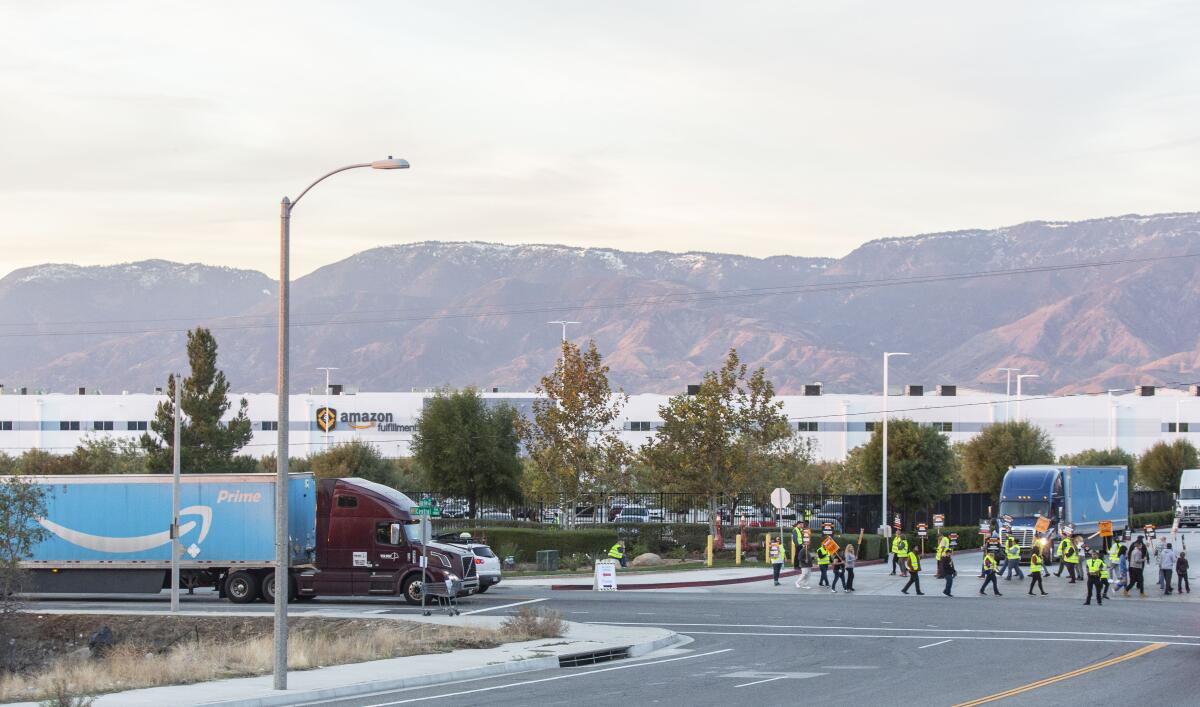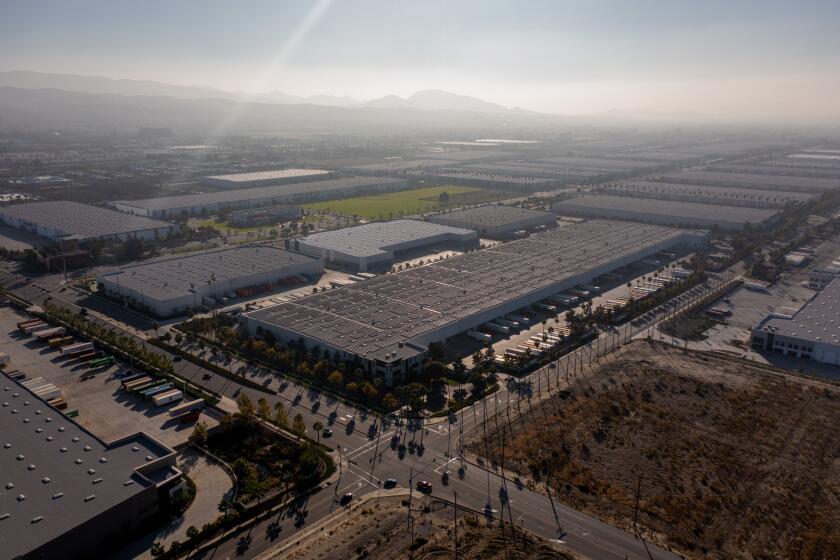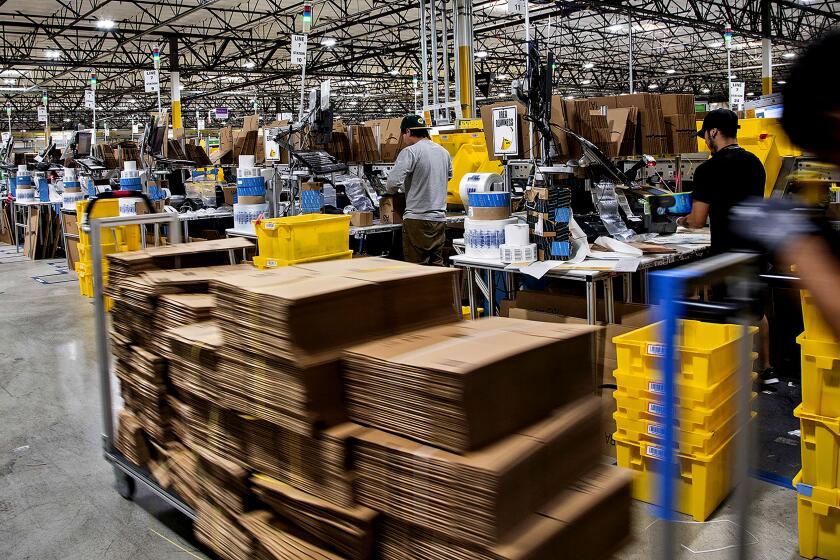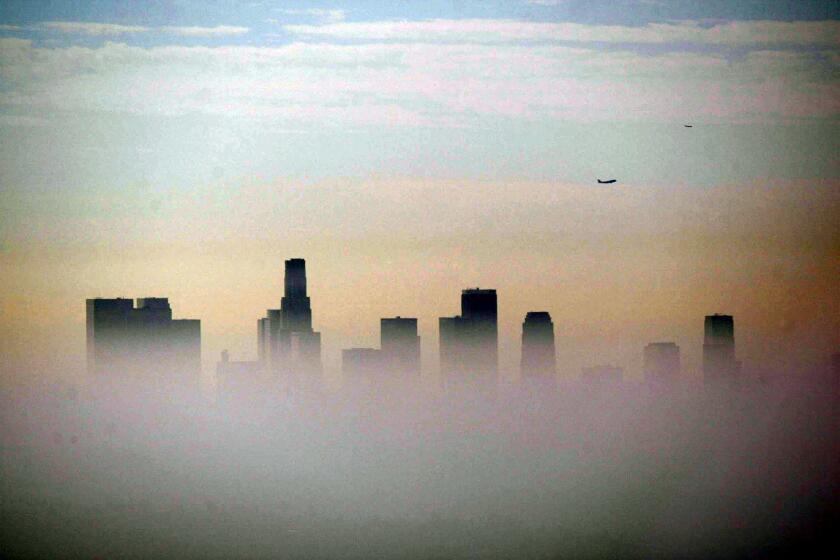Why Amazon warehouse workers walked off the job in San Bernardino

- Share via
Warehouse workers at Amazon’s largest air freight facility on the West Coast walked off the job Monday, demanding higher pay and relief from hot conditions they say are unsafe.
Organizers with a group called Inland Empire Amazon Workers United said in a Facebook post that 160 employees walked out at the San Bernardino International Airport facility, which is a critical part of Amazon’s logistics network and one of the company’s three U.S. “air hubs.”
In a statement, Amazon officials disputed the number, saying that 74 out of roughly 1,500 employees at the facility walked out.
About 900 employees at the San Bernardino airport have signed a petition calling for base pay to be increased from $17 per hour to $22 per hour, Inland Empire Amazon Workers United said in a statement.
“Amazon could deliver a higher standard for workers, but they don’t,” said Sara Fee, who has worked at the air hub since it opened in March 2021. “A warehouse is just a warehouse. A company is just a company. The people are what makes it all work, and we are strong and united to fight for what we deserve.”
Contributor: We mapped the warehouse takeover of the Inland Empire. The results are overwhelming
The collective footprint of Inland Empire warehouses covers more than a billion square feet. That’s right, a billion. It signals a need for change.
Amazon is the largest private sector employer in the Inland Empire, organizers said. Of the more than 200,000 warehouse workers in the region, 1 in 5 work at Amazon facilities.
“Amazon promised the Inland Empire quality jobs,” organizers said in another Facebook post. “They failed to deliver. Amazon has forced us to work in extreme heat, barely paid us enough to afford rent, and now we are being retaliated against for speaking up.”
Paul Flaningan, an Amazon spokesperson, said the company respects employees’ right to make their opinions known outside the workplace and that there were “many established ways” that workers can voice concerns internally.
“We are proud to provide full-time employees at our San Bernardino Air Hub and throughout the region a minimum starting wage of $17 an hour,” Flaningan said. “Depending on their shift, our full-time employees can earn up to $19.25 an hour and receive industry-leading benefits including healthcare from Day 1, 401(k) with 50% company match, and up to 20 weeks paid parental leave.”
Amazon officials are continuously listening to concerns and looking at ways they can improve, he said, adding that the company provides competitive pay, comprehensive benefits and an “engaging, safe work experience.”
In July, workers submitted a petition calling for pay increases during Amazon’s Prime Week sales event, saying their wages are not enough to live on in Southern California.
In the petition, employees said workers making $17 per hour and working 40 hours per week take home about $2,200 per month, but the average rent in California is $1,700 and the average in San Bernardino is $1,650, “meaning that over 75% of our income is going to rent alone.”
“We can barely afford to live in today’s economy,” the petition said.
AB 701 is the first legislation in the U.S. regulating warehouse performance metrics. The new California law aims to crack down on harsh work standards in Amazon fulfillment centers.
The workers also expressed concern about unsafe working conditions caused by excessive heat.
During July, temperatures reached at least 95 degrees at the airport on 24 days, organizers said.
When employees confronted managers, Amazon created an additional rest area, but unsafe conditions remain “in many work areas,” according to the statement.
“Working in the heat feels like you are suffocating,” said Melissa Ojeda, who has worked at the facility for more than a year. “You need to take breaks and you can overheat really easily. They don’t make it easy to take breaks to allow your body to cool down.”
When the San Bernardino air hub opened last year, organizers said, some in the community raised concerns about the quality of jobs at the facility and its effects on air pollution.
With time running out to meet a decades-old air quality standard, local regulators are threatening to sue the federal government.
A 2018 study found that Amazon’s flights into and out of airports in Riverside and San Bernardino counties released about 620,000 metric tons of carbon dioxide into the atmosphere and that the two counties had the worst ozone pollution in the country, pollution that was largely attributed to the warehousing industry, according to Amazon Workers United’s statement.
Amazon operates 14 flights a day in and out of the 24-hour facility on the site of the former Norton Air Force Base, the organizers said.
“Amazon has said its goal is to operate 26 flights a day,” they said. “The number of workers at the warehouse fluctuates, currently about 1,300 but more than 1,800 in peak season, demonstrating the lack of stability in these Amazon jobs.”
More to Read
Sign up for Essential California
The most important California stories and recommendations in your inbox every morning.
You may occasionally receive promotional content from the Los Angeles Times.














